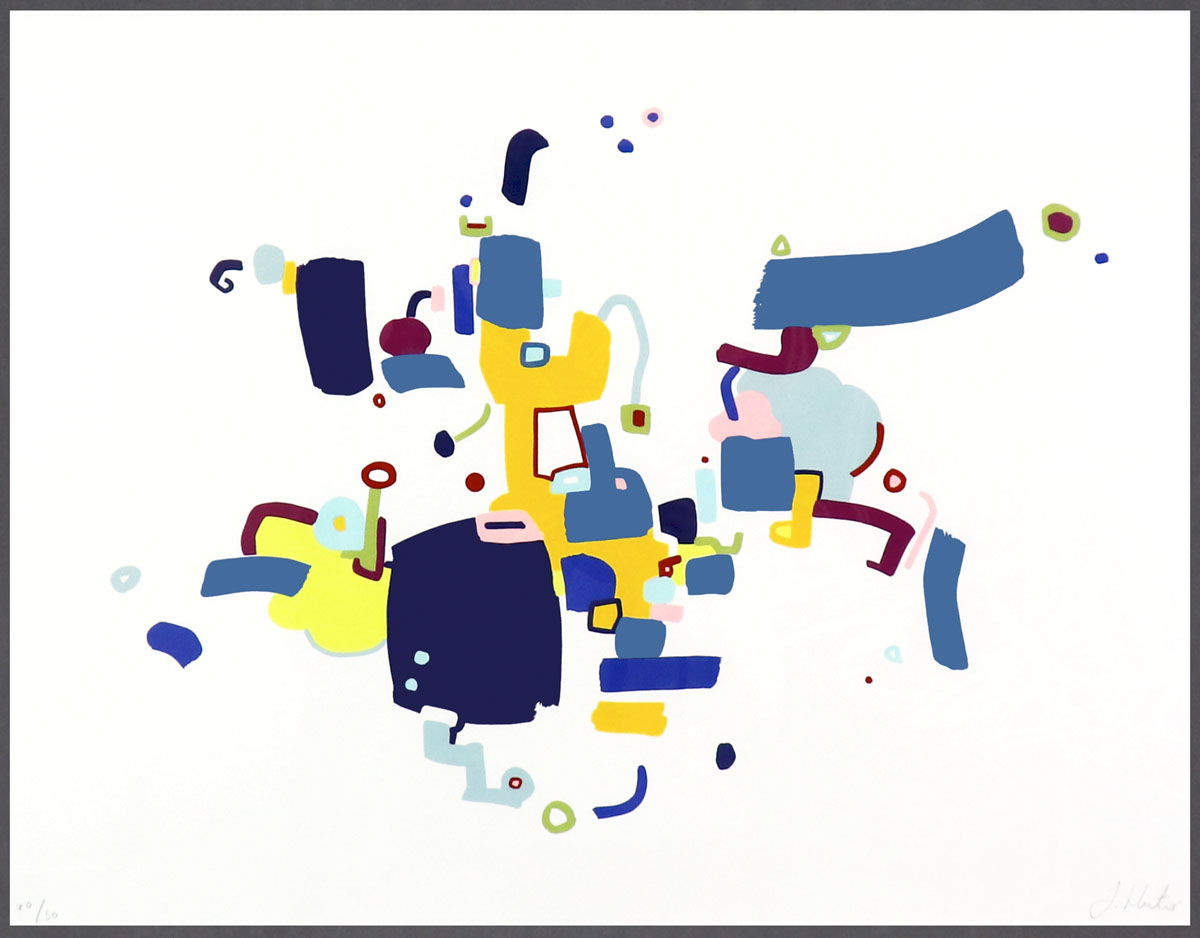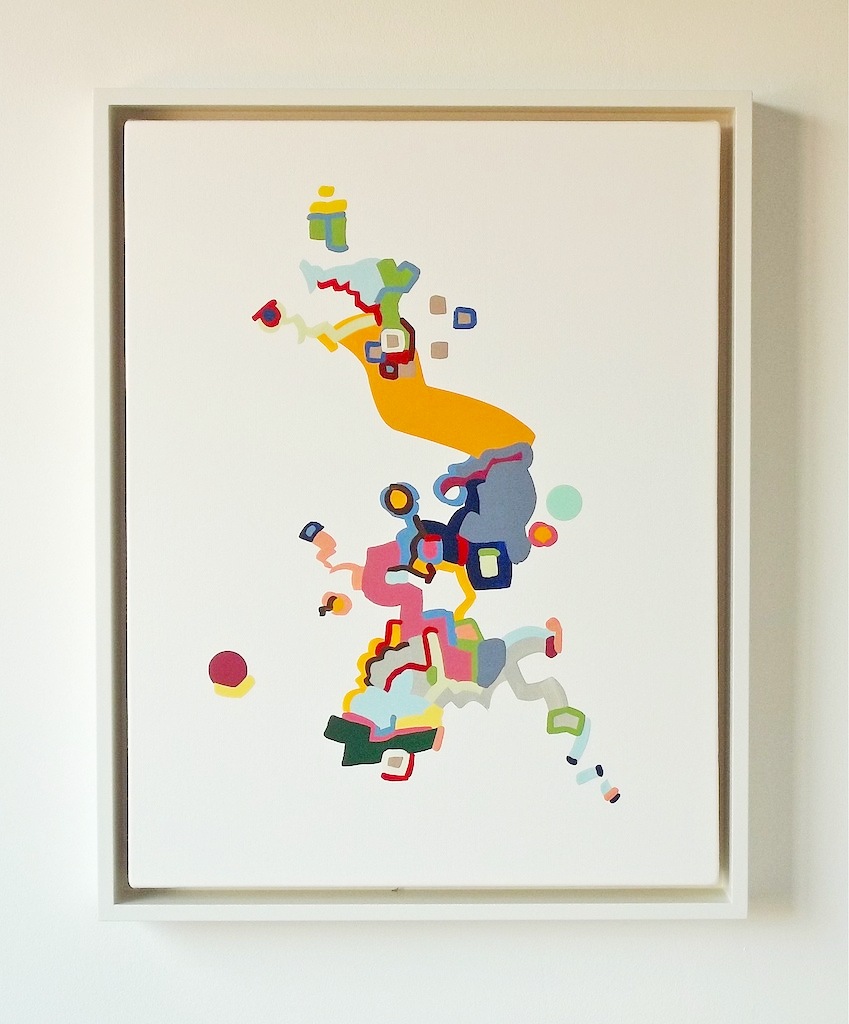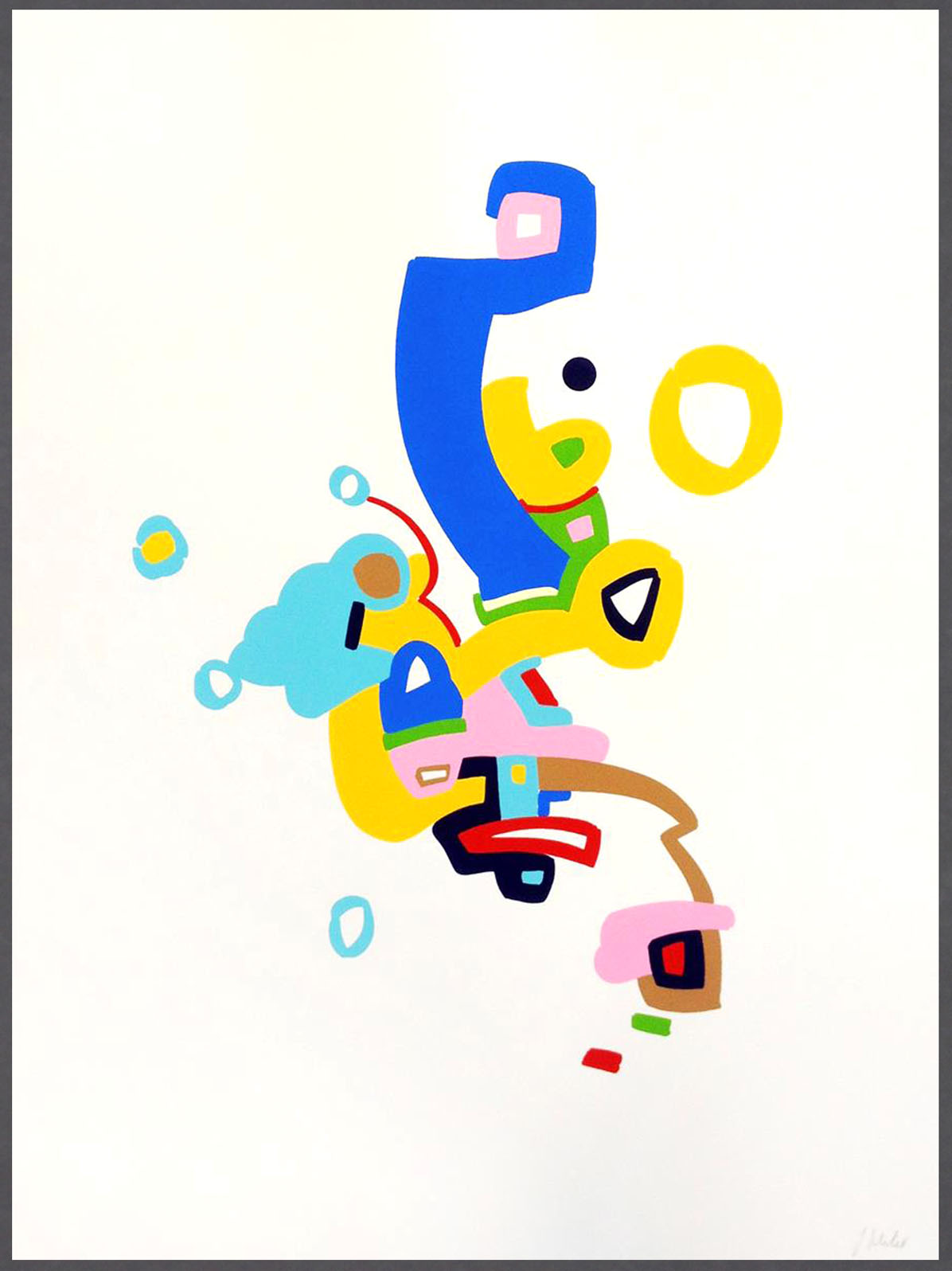Balancing shapes and colours without the presence of any preconceived form and thought,
James Hunter has conquered a practice where the image is gradually built, without consciously planning how one brushstroke will inform the next. A futuristic robot from the fifties, a mechanical turtle or a disco-dancer emerges from the imagery, prompted only in the mind of the viewer trying frantically to come to reason of what the artist is showing us. From a productive period at the beginning of Hunter’s practice, the screenprint
Orangeola hints the conclusion of the first part of his career; a period up until 2016 where he formed his abstract approach and distinct style.
Wandering along the forest clearings and rocky beaches of Öland, a narrow and lengthy Swedish island in the Baltic Sea, the sharp-eyed walker may be lucky to suddenly stumble across small sculptures along the path, made from various sized rocks gracefully balancing on top of each other. The shapes of these creations defy all understanding of gravity as they reach upwards, balancing the weight, shape and volume of each rock to stabilise the whole construction. So fragile is the balance that if the top stone is removed, as tiny and seemingly unimportant as it may look, the equilibrium will be offset and all the rocks will instantly collapse to the ground. It is said that the key to success for the artists who create these wonders, is the ability to empty the mind in the process and feel the greatness and contribution of each rock.
As a painter, before making the first brush stroke on a blank canvas, Hunter follows the same almost spiritual process of a rock balancer; trying to clear his mind and reach a place where the outside world does not intentionally influence his work.
The genre known as Surreal Automatism first appeared in the early twentieth century among the French surrealists, and over time it found its way into many practices of famous artists such as Joan Miro, Salvador Dali and in the later works of Pablo Picasso. However renowned the genre may sound, it covers a broad spectrum of artists and their body of works, that the viewer may not be able to differentiate the many abstract forms - and which ones derive from Automatism. The main philosophy within Automatism is that it does not spring from a figurative source, compared to other abstract compositions which may originate from something specific, like a construction, a human or a piece of fruit. This is the true appeal of this branch of Surrealism; whatever the viewer sees is entirely subjective and only exists in the personal imagination.

JAMES HUNTER
Orangeola, 2016
Edition of 50
92(w) x 71(h) cm
36.42(w) x 28.15(h) inches

JAMES HUNTER
Orangeola, 2016
Edition of 50
92(w) x 71(h) cm
36.42(w) x 28.15(h) inches
|
|
|
92(w) x 71(h) cm
36.42(w) x 28.15(h) inches
|
11-colour screen print on Somerset Satin 410gsm paper with hand torn edge
Signed and numbered on front.
Edition of 50
|
|
The visual inventiveness very much plays a part in how Hunter’s work is seen. What can initially appear to be a collection of abstract shapes piled on top of one another soon becomes something else as the conscious mind begins to decipher what it is the artist is trying to portray. Though the observer is aware of the works being abstract, figures and animals can be seen in pieces such as
Orangeola - and in other compositions landscapes appear when trying to relate the title to the image. It is often difficult to accept the shapes are not figurative when studying something completely abstract. But the way in which Hunter works do confirm that the images are in fact entirely abstract. Starting usually from the middle of the work, he builds the image, connecting each abstract shape to the next, only limited to the size of the paper and chosen palette. In
Orangeola, the complementary tones of tangerine orange, electric yellow, and Persian and velvet blues, dominate the image and signifies the importance of choosing a colour palette that brings harmony and balance to the whole composition.
To get a full understanding of the artist’s work, the three years he spent as a studio assistant to
Damien Hirst and being part of a team who painted the famous pharmaceutical spot paintings, is of vital importance in what way his practice developed. In reality, how the two artists’ history intertwine is far more fascinating than who Hunter’s first employer was. Hirst’s earliest spot paintings were canvases of random, unequal and dripping brush marks, influenced by the Abstract Expressionists from the sixties. Only through Hirst’s constant aim for perfection - and the conceptional approach to colour and moods - did the endless combinations become the works of immaculate rows and columns of dots that everyone recognises today. Some of these works are anonymously painted by Hunter.

JAMES HUNTER
Miss Jessop's Upright, 2013
37(w) x 47(h) cm
14.57(w) x 18.50(h) inches

JAMES HUNTER
Miss Jessop's Upright, 2013
37(w) x 47(h) cm
14.57(w) x 18.50(h) inches
|
|
|
37(w) x 47(h) cm
14.57(w) x 18.50(h) inches
|
Enamel and acrylic on canvas in white box frame (no glass)
|
|
Hunter’s abstract works arise from the controlled restraints of Hirst’s vision and subsequently - or perhaps as a natural progression - shifted his own practice to the other extreme; a place where abstract form and randomness could freely evolve. From his years of repetitive spot paintings, two habits would eventually follow Hunter in his personal artistic journey; the selection of titles for his artworks from some endless compendium, Hirst choosing his in a catalogue from Sigma-Aldrich Pharmaceutical and Hunter from an Encyclopaedia of plants; and the feature of one perfect, circular dot in all his work. However, in the artist’s latest paintings on canvas, the dot was noticeably absent, perhaps signalling a change to come.
Following the debut of
Elegantissimum in 2014, the artist’s third screenprint edition,
Orangeola, was released in a collaboration between James Hunter and Eyestorm two years later. The 11-colour screenprint is the most elaborate print edition to date and is the first where the artist worked in a horizontal rectangular format, contrary to his preferred vertical layout as seen in his paintings. The edition of 50 is signed and numbered on front.
You can find more information about
Orangeola and other works by
James Hunter on his artist page
here.

JAMES HUNTER
Elegantissima, 2014
Edition of 50
58(w) x 79(h) cm
22.83(w) x 31.10(h) inches

JAMES HUNTER
Elegantissima, 2014
Edition of 50
58(w) x 79(h) cm
22.83(w) x 31.10(h) inches
|
|
|
58(w) x 79(h) cm
22.83(w) x 31.10(h) inches
|
9 colour screenprint with varnish 410gsm Somerset Satin with hand torn edge.
Signed and numbered on front.
Edition of 50
|
|